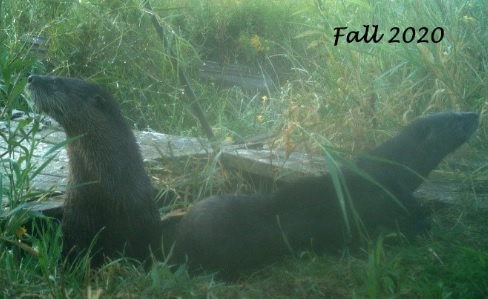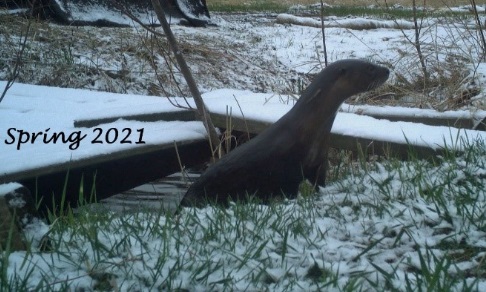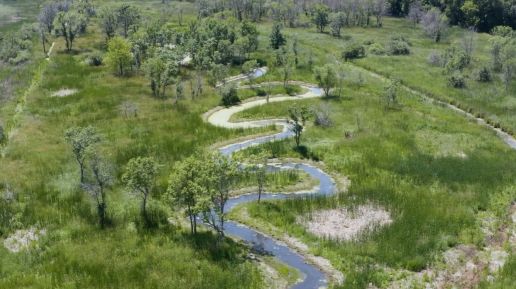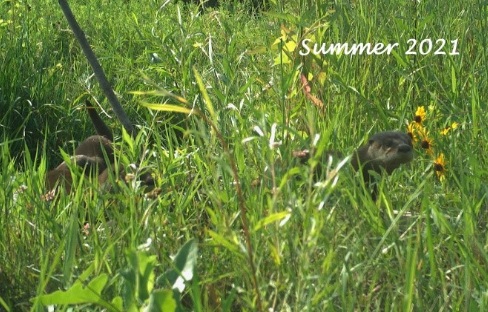Otters in the Watershed
If you’ve been following otter updates on our website and social media, you already know that we are especially fond of otters here in the Vadnais Lake Area Watershed. Our past efforts to learn more about our urban otters have included: remote-camera monitoring watershed-wide to document otter habitat use and activity patterns, otter scat analysis for parasites to learn more about the health of our urban otters, and the Otter Spotter StoryMap where residents can report their otter sightings and help us continue to learn more about otter distribution in the watershed.
Water management and habitat connections
The Lambert Lake pond and meander project presented an exciting opportunity to combine water management and habitat improvements. During the winter of 2020/2021, a meander was constructed where there used to be a straight-line ditch. This was done to create a more natural stream shape, allow water-quality treatment, and reconnect the creek to its floodplain. Vinyl sheetpile was also replaced with steel to ensure continued flood control and water-quality treatment in the Lambert Lake stormwater pond.
To complete construction in a floodplain area, VLAWMO worked with agencies such as the MN DNR to assess possible environmental impact and benefits of the project. Rare species in the general area include Blanding’s turtles and Rusty patched bumble bees. We made plans to ensure rare species’ safety during construction.
Learning more about our urban otters
Otter activity was monitored at the Lambert Lake site during previous remote-camera surveys. We were surprised to see relatively high otter activity at a low-quality stormwater pond with low-diversity wetlands. This site is connected to higher-quality habitat in Vadnais-Sucker Park via Lambert Creek.

Otters are a priority species because they are indicators of habitat and water quality and because they are top-tier predators. We wanted to know how well the final project would support otters because they help us understand how the site may be providing improved habitat to other species as well. We set up a remote camera at the latrine site—a kind of otter communication station and the spot where everybody poops when they’re in the neighborhood—well in advance of the planned construction so we could measure otter activity before, during, and after construction as a snapshot of how the habitat may be functioning.

Otters are important for a variety of reasons; they are also really fun to observe. Their playful nature is captivating, and an otter visit at the latrine is always a treat to get to see in the photos and videos that result. Over the course of a full year, from July 29, 2020, through August 3, 2021, we observed 64 otter visits at the Lambert latrine. We’ve seen interesting interactions too, like the time an otter faced off with a pack of 3 coyotes. The otter stood its ground and was unharmed. We’ve watched second-year young traveling with mom; seen the young traveling in their own little group of 3 after dispersing from mom; and, in mid-July, 2021, we saw mom with her new litter. We often see lone males visit the site just after mom and the cubs were there.
The latrine is the spot where everybody poops. When otters stop by, they also roll around in the grass and scrape grass into piles, leaving distinctive grass balls near the latrine. The rolling is thought to aid in grooming and increasing the scent that an otter leaves behind after its visit. Otters also do a funny little stomping dance while they poop. They do this because they have scent glands in their feet. The dance helps release scent and stamp it into the grassy ground where it adds to their communication information at the site. Otters don’t defend territories like some animals do. Their territories tend to overlap. Latrines, as communication stations, let otters in the area know who has recently visited and share important information about reproductive status and possibly even food availability.
Pre, During, and Post Construction
The Lambert site doesn’t only support otters. The camera has also recorded: Coyotes, Raccoons, Striped skunks, Mink, Muskrats, Opossums, White-tailed deer, Gray squirrels, Mice, Wild turkeys, Great-blue herons, and more. Prior to construction, we monitored the site with the remote camera from July 29 to December 7, 2020. That gave us a total of 133 trapnights (or ~4.4 months) prior to construction. We had 32 otter visits during this time and an average of a visit every 4.1 trapnights. Construction activity started on December 7, 2020. Heavy equipment and major construction activity was completed by March 1, 2021. There were no otter visits during this time. Otters began visiting the site again on March 7, 2021. There was a flurry of otter activity in the first few nights after they apparently rediscovered the site post-construction. From March 7 to August 3, 2021, the camera was rolling. This gave us a possible 149 trapnights post construction, but we had some vegetation grow in quickly in the early summer that obscured the camera, then battery failure after that. We lost 27 trapnights during this time, resulting in a total of 122 trapnights (~4.1 months) and otter 32 visits post construction.

A pre-construction average of a visit every 4.1 trapnights compared to a post-construction average of an otter visit every 2.9 trapnights is promising. It doesn’t tell us anything conclusive because it’s only 1 latrine site over a fairly limited amount of time. However, it does tell us that otters are continuing to find the site attractive and visiting frequently now that construction is complete. We hope that trend continues. In the meantime, we’ve seen otters mating. We’ve seen them in confrontation with another species (coyotes) and win. We’ve seen successful litters traveling with mom over time and on their own after dispersing. We see playful interactions between individuals in family groups, and we get to see otter families grow and change over time.
Key insights
- Knowledge about otter activity provides evidence that our urban environment has the potential to support wildlife habitat for otters and other species where they are able to successfully breed and disperse (instead of just passing through).
- This kind of biological monitoring also supports that water management focused on human needs can also provide benefits for wildlife. Such strategies help organizations like VLAWMO accomplish multiple goals at the same time.
To see otter footage and sighting reports, visit the Otter Spotter StoryMap. If you see otters out and about in the watershed, please record what you observe, take a photo if you are able, and tell us about it.
Dawn Tanner, PhD
Program Development Coordinator


